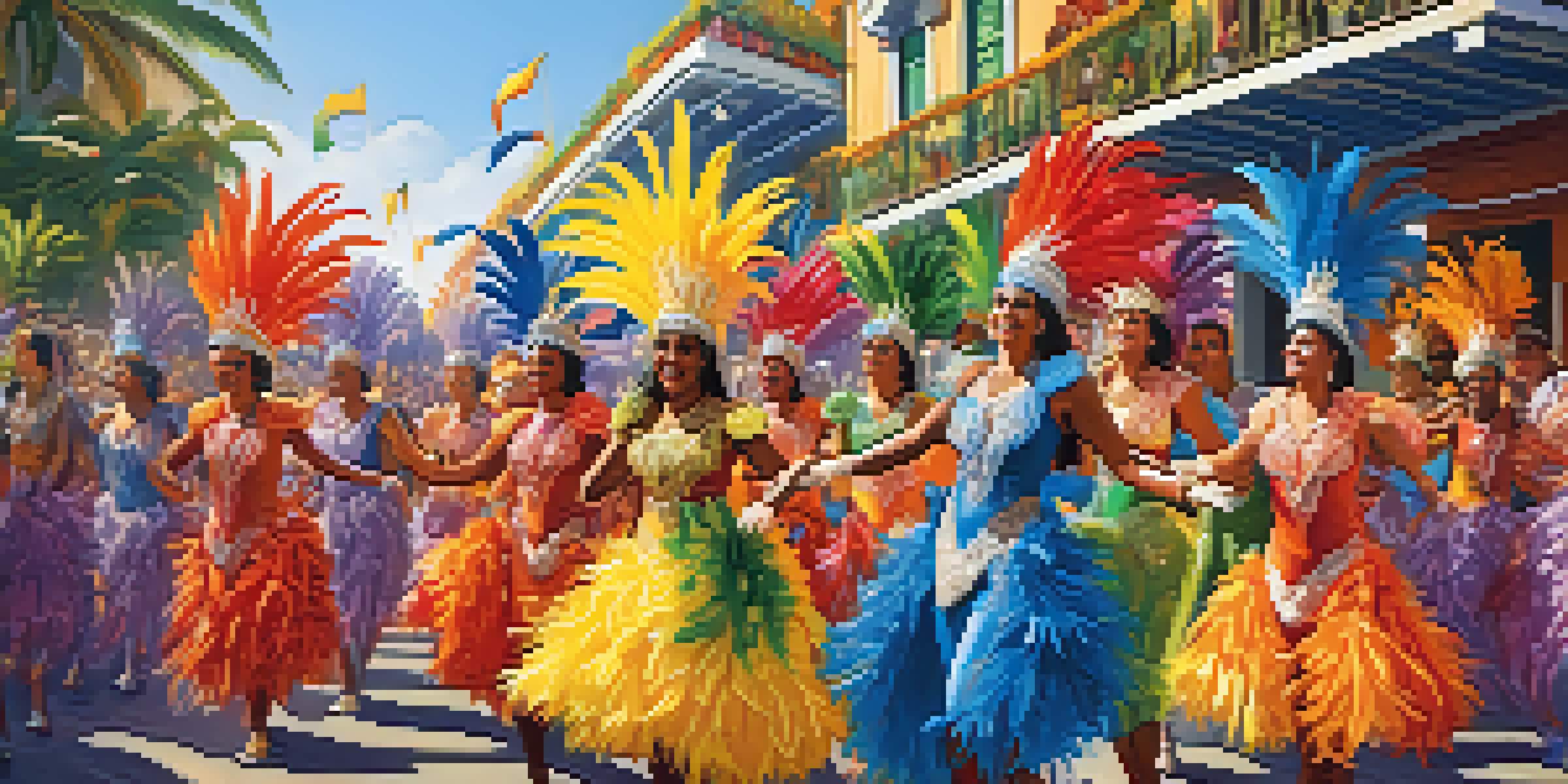Samba and Healing: The Role of Dance in Brazilian Culture

The Cultural Significance of Samba in Brazil
Samba is more than just a dance; it's a vibrant expression of Brazilian culture. Originating from African rhythms and traditions, it embodies the spirit of joy, resilience, and community. Its lively beats and colorful movements bring people together, fostering a sense of belonging that transcends social barriers.
Dance is the hidden language of the soul.
In Brazil, samba is often associated with Carnival, a festival that showcases the country's rich heritage. During this time, samba schools compete in grand parades, illustrating stories of struggle and triumph through elaborate performances. This celebration not only highlights samba's artistic value but also serves as a collective healing experience for participants and spectators alike.
The dance's roots in African history further deepen its cultural significance. Samba acts as a reminder of the resilience of the Afro-Brazilian community, transforming pain into joy through rhythm and movement. This connection to history enriches the experience of samba, making it a vital part of Brazil's cultural identity.
Dance as a Form of Healing
Dance has long been recognized as a powerful therapeutic tool, and samba is no exception. The act of dancing can release endorphins, which help combat stress and anxiety. For many people, engaging in samba provides an emotional outlet, allowing them to express feelings that might be difficult to articulate otherwise.

Moreover, samba encourages social interaction, creating a sense of community that is essential for mental well-being. When individuals participate in group dance, they experience a shared connection that fosters support and understanding. This communal aspect of samba can be particularly healing for those going through tough times, offering a safe space to share experiences and emotions.
Samba as a Cultural Expression
Samba embodies Brazilian culture, reflecting joy, resilience, and community through its vibrant rhythms and movements.
The rhythm of samba also plays a crucial role in the healing process. The upbeat tempo and lively music can elevate one's mood, while the physical movements promote physical health. By immersing oneself in samba, dancers often find a renewed sense of vitality and purpose, making it an essential practice for overall well-being.
Samba and Community Building
Samba is a catalyst for community building in Brazil, bringing people together from all walks of life. Through samba classes, workshops, and performances, individuals forge connections that can last a lifetime. These gatherings create a sense of unity, where differences are celebrated rather than seen as barriers.
The body says what words cannot.
In many neighborhoods, samba serves as a way to preserve cultural heritage while promoting inclusivity. Community samba groups provide a platform for individuals to share their stories and experiences, fostering dialogue and understanding among diverse populations. This communal engagement not only strengthens relationships but also nurtures a sense of pride in one's identity.
The impact of samba on community dynamics can be profound, especially in marginalized areas. By participating in samba, individuals often gain confidence and a sense of belonging, empowering them to contribute positively to their communities. This ripple effect demonstrates how dance can transcend personal healing, leading to collective growth and resilience.
The Therapeutic Benefits of Rhythm and Movement
Rhythm is a fundamental element of samba, and it holds powerful therapeutic benefits. The repetitive beats and patterns in samba help synchronize the body and mind, promoting relaxation and focus. Engaging with rhythm allows dancers to escape from daily stresses and immerse themselves in the present moment.
Movement in samba also serves as a form of expression, allowing individuals to convey emotions and stories through their bodies. This physical expression can be incredibly cathartic, providing a release for pent-up feelings. As dancers move to the music, they often find a sense of freedom and liberation that contributes to their overall healing process.
Healing Through Dance
Engaging in samba offers therapeutic benefits by promoting emotional expression, reducing stress, and fostering social connections.
Additionally, samba's dynamic movements promote physical fitness, which is crucial for mental health. Regular physical activity is known to reduce symptoms of anxiety and depression, and samba offers an enjoyable way to stay active. The combination of rhythm, movement, and music creates a holistic experience that nurtures both body and mind.
Samba in Healing Practices and Therapy
Incorporating samba into healing practices is becoming increasingly popular in Brazil and beyond. Therapists and wellness practitioners recognize the benefits of dance as a way to enhance traditional treatment methods. By integrating samba into therapeutic sessions, they create an engaging environment that encourages self-expression and emotional exploration.
Workshops and retreats that focus on samba often blend dance with elements of mindfulness and meditation. Participants are encouraged to connect with their bodies and emotions, promoting a deeper understanding of themselves. This holistic approach allows individuals to navigate their healing journeys with greater ease and compassion.
The use of samba in therapy not only aids individual healing but also fosters community support. Group sessions encourage participants to share their experiences, creating a network of understanding and empathy. This sense of collective healing reinforces the idea that dance, particularly samba, can be a transformative force in one's life.
Personal Stories of Healing Through Samba
Many individuals have found healing through samba, and their stories are a testament to its power. For example, a young woman who struggled with anxiety discovered samba classes as a way to cope. Through the rhythm and movement, she felt her worries fade away, replaced by joy and connection with others.
Another inspiring story is that of a man who turned to samba after experiencing loss. Initially hesitant, he found solace in the dance community, where he could share his grief and celebrate life. The support he received from fellow dancers helped him heal and rediscover his passion for life.
Community Building via Samba
Samba acts as a catalyst for community building, uniting individuals from diverse backgrounds and nurturing a sense of belonging.
These personal narratives highlight how samba transcends mere entertainment; it becomes a lifeline for many. By sharing their journeys, these individuals inspire others to explore the healing potential of dance, reminding us all of the power of rhythm and community.
The Future of Samba and Healing
As awareness of the healing benefits of samba grows, its integration into wellness practices is likely to expand. More community organizations and wellness centers are recognizing the value of dance as a therapeutic tool. This trend not only promotes the cultural significance of samba but also enhances its role in holistic health approaches.
Innovative programs that blend samba with other therapeutic modalities, such as yoga and mindfulness, are emerging. These initiatives aim to create comprehensive wellness experiences that address both physical and emotional health. The future of samba in healing practices looks promising, with endless possibilities for growth and adaptation.

Ultimately, samba's ability to unite people while providing a means of expression and healing will continue to resonate. As more individuals embrace the dance, they contribute to a legacy that celebrates resilience, community, and the transformative power of movement. The journey of samba in Brazilian culture is far from over; it is evolving, and its impact will undoubtedly endure.